Today I held a hibernating squirrel. Yep, you heard that right - A HIBERNATING SQUIRREL! An Arctic Ground Squirrel to be exact.
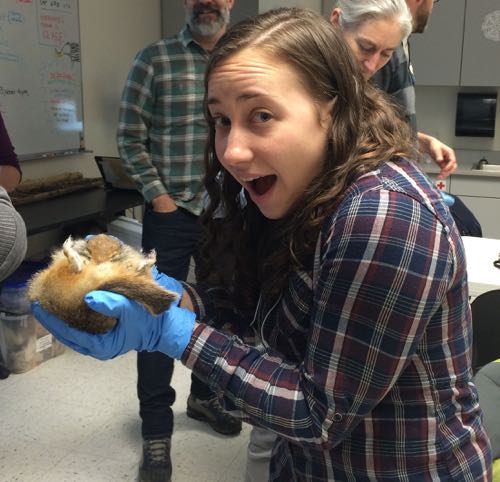
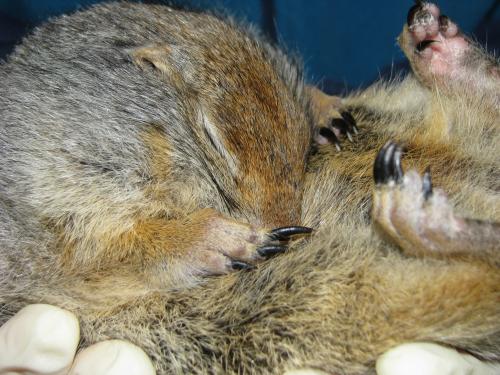
Okay, hold on, back up a minute. How can I, a human, hold a hibernating squirrel...without waking it up?
Let's start from the beginning.
What is Hibernation?
Hibernation is the extended time period during which the animal:
- experiences a reduced body temperature
- stops eating
- stops going to the bathroom
- enters an inactive state
Who Hibernates and Why?
If you're imagining a bear curled up for the winter, you have the right idea. But it turns out a variety of animals hibernate - wood frogs, chickadees, and (you guessed it) arctic ground squirrels.
Basically arctic animals have two options when the cold of winter approaches: leave or stay. Many animals, such as the Canadian Goose, opt to leave, migrating to warmer regions. But those who stay need to figure out how to stay active or hibernate.
Do the Squirrels in My Backyard Hibernate?
Well, it depends where you live. If you're in an arctic region, probably. If you're not in an arctic region, maybe.
While arctic animals definitely hibernate to survive the cold of winter, non-arctic animals could hibernate to survive hot weather, cold weather, dry weather, and/or a minimal food source.
Ground squirrels (those that dig a burrow) often hibernate whereas tree squirrels (those that build a nest up in a tree) can oftentimes find pine cones, remaining berries or other food sources through the winter and will therefore not hibernate.
Why Should We Care So Much About Squirrels Hibernating?
There are actually wide variety of applications that could benefit from Arctic Ground squirrel hibernation research:
- Appetite Control - If squirrels can survive in a hibernated state not eating for months, could humans?
- Longevity - Is hibernation the fountain of youth?
- Therapeutic Hypothermia - What usually kills a person is not the injury itself, but the inflammation that follows. Could purposely giving a patient hypothermia decrease this inflammation?
- Preservation of Donor Organs for Transplant - How can we keep organs alive long enough to transplant them?
- Space Travel - Can humans hibernate? For how long? Would it be long enough for us to travel to a different planet? Beyond?
What Do We Know About the Arctic Ground Squirrel?
The squirrel that I got to hold is an Arctic Ground Squirrel. These squirrels generally hibernate from September through February (for males) or April (for females).
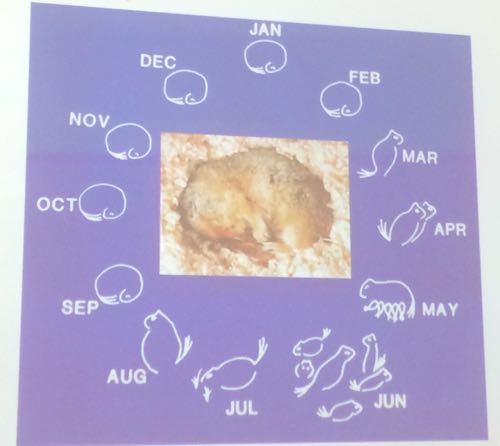
While hibernating, the Arctic Ground Squirrel experiences:
- Lower metabolic rate - 2% of normal
- Lower body temperature - 28F or 2C...that's below freezing!
- Slow breathing - 1-3 shallow breaths per minute
- Slow heart rate - 1 beat per minute; for comparison, a human's resting heart rate is ~60 beats per minute
- Decreased blood pressure
- Lower blood supply to brain - 2% of normal; for comparison, if a human had this low of blood supply to the brain they'd be having a stroke
- No brain activity - as measured by an EEG...so no dreams here
You can see their body temperature steadily decrease as the squirrel enters hibernation, and gradually increase towards the end.
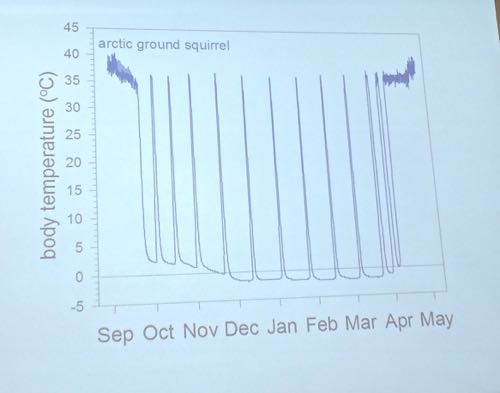
You may notice the spikes in the graph above. This shows that once a month the squirrel "wakes up" and is active for about 24 hours. Although not uncommon for hibernating animals to have short but regular active periods, scientists aren't exactly sure why the squirrels do this.
To end their hibernation, male squirrels wake up in March. Each year, the male squirrel goes through puberty (can you imagine?!) to prepare for reproduction. In April, the males are ready to mate. At this time, the males nosy their way into the female's burrow (she's still hibernating) and poke, nuzzle, prod, and annoy her until she wakes up. What a rude alarm clock.
The two squirrels mate and after about three weeks the female gives birth to another generation. The little family eats and eats to prepare for the winter, when they will hibernate again.
How do Scientists Collect This Data?
Scientists use what's called an iButton, a tiny implant that records the squirrel's temperature throughout hibernation.
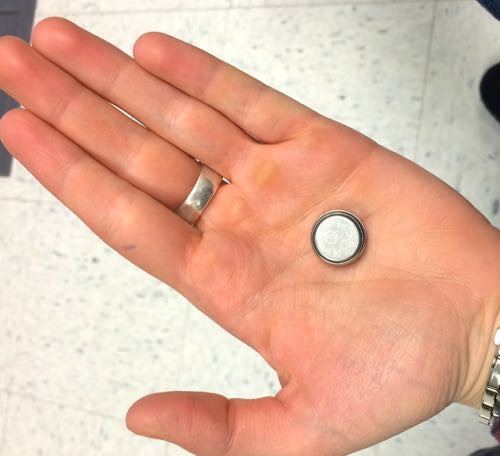
This device records once every four hours.
Scientists have been implanting iButtons in Arctic Ground Squirrels since 1993. With 200-300 squirrels tracked per year, their data set is now more than 2000 squirrels.
What Are Scientists Curious About?
- Circadian Clock - A Circadian Clock is kind of like your internal clock. It governs when you wake up, eat, and go to sleep. Usually the light outside helps to set your clock , which is why looking at a phone or watching tv right before bed makes for some restless sleep. In the arctic circle during summer, there can be as much as 24 hours of daylight, and in the winter 24 hours of darkness. So how do the squirrels know when it's time to hibernate? How do they know when it's time to "wake up?" Would you be able to tell lunchtime if you were locked in a windowless bunker?
- Activity Once Per Month - The data shows that these squirrels are active for one day just about each month. Why? What benefit does this bring the squirrel? Why does this happen at the same time each month?
- Climate ChangeA statistically significant variation in either the mean state of the climate or the mean variability of the climate that persists for an extended period (typically 10 years or more). Climate change may result from such factors as changes in solar activity, long-period changes in the Earth's orbital elements, natural internal processes of the climate system, or anthropogenic forcing (for example, increasing atmospheric concentrations of carbon dioxide and other greenhouse gases). - We know the Earth is overall getting warmer, which in turn means less snow, less ice, and (usually) less winter. How does this different climate affect the squirrels hibernation cycle? If the hibernation cycle is shortened, does that in turn affect the squirrels' ability to reproduce in the spring?
- Insert Your Question Here - Seriously, there is so much to be learned about squirrels and their hibernation patterns. This is cutting edge research and I'm curious to see what we learn next!
How Are Lab Squirrels Stored?
Hibernating squirrels are kept in a freezer. Seriously. The freezer is meant to simulate the natural temperatures of their arctic habitat.
The squirrel that I held was brought to me in a cooler...the same one you'd pack a picnic in. The squirrel buried itself with some soft material, burrowing down just as she would do in the ground.
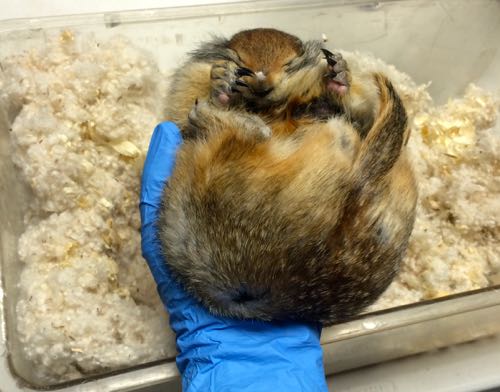
What Does a Hibernating Squirrel FEEL Like?
Cold. Not too stiff, not too frozen, but overall cold.
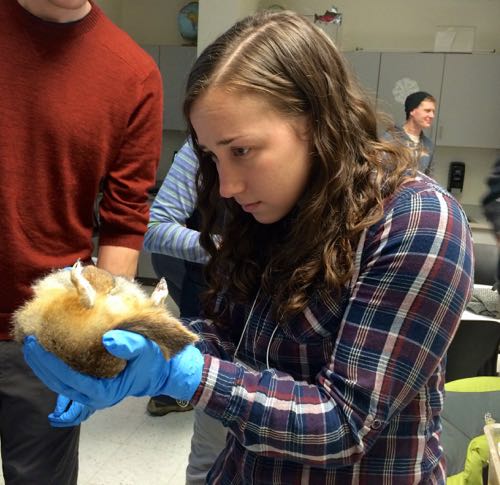
She remained all curled up in my hands, breathing extremely slow and twitching from time to time.
Did She Wake Up?
Kind of. After being held by several humans, the squirrel had started to heat up. It's for this reason that she started to move a bit more, kind of like when dogs twitch while sleeping. The researcher told us she'd fully wake the squirrel up after we left to make sure it didn't get used to sleeping through these types of events.
To my surprise, she was not waking up because we were disturbing her physically. You could do almost anything to this squirrel (like drop it on the floor...but of course I wouldn't do that) and she wouldn't wake up! Pretty incredible.
What Else Was There to See?
Since we were already at the Museum of North, we took time to explore. Here's a video compilation of some of my favorite museum exhibits.


Comments